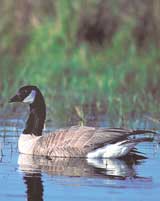Recovered Species
A Wildlife Management Success Story
Recovery, or delisting, is the process by which the decline of an endangered or threatened species is arrested or reversed, and threats are removed or reduced so that the species’ long-term survival in the wild can be ensured. The recovery process is not fast; it takes years to address threats that were years in the making.
Through successful efforts of the Endangered Species Act (ESA), threatened and endangered species have been recovered or downlisted. ESA’s efforts have prevented extinction or further decline through acquiring and restoring habitat, monitoring species for their abilities to survive on their own, and determining that threats have been eliminated or controlled.
When hunters buy hunting licenses, guns, ammunition, or other outdoor equipment, fees and taxes are collected on these purchases. These dollars help fund programs for conservation and preservation.
Many factors contribute to a species becoming endangered—disease, insecticides, predators, introduction of non-native species, habitat reduction or pollution, lack of land management, and hybridization. In most cases, however, hunting does not contribute to a species being classified as endangered or threatened.
American Bald Eagle
A true success story is America’s national bird, the American Bald Eagle. In 1967, the bald eagle was declared an endangered species.
Through efforts of the ESA and numerous other public and private conservation agencies, the bald eagle was delisted to recovery status in 2007.
- Then
- Less than 500 nesting pairs
- Now
- More than 9,000 breeding pairs
American Peregrine Falcon
The American Peregrine Falcon was placed on the endangered species list in 1973 when it became nearly extinct. At its 1999 delisting, more than an estimated 1,800 breeding pairs were thriving. During the recovery effort, more than 6,000 peregrine falcons were released into the wild by government and private raptor specialists. Some of the reintroductions took place in urban areas after researchers discovered that the falcons can adapt successfully to nesting on skyscrapers and other urban structures where they hunt abundant pigeons and starlings.
- Then
- Nearly extinct
- Now
- More than 1,800 breeding pairs
Aleutian Canada Goose
Only 200 to 300 Aleutian Canada Geese were thought to remain by the time the species was listed as endangered in 1967. The goose’s problems began when fur farmers and trappers released Arctic and red foxes on more than 190 islands within the goose’s nesting range in the Aleutian Islands of Alaska. Most fox releases took place during the height of the fur industry from 1915 to 1936, but some occurred as early as 1750. The foxes nearly wiped out the Aleutian Canada goose populations because the birds had developed no natural defenses against land predators on the previously mammal-free islands.
The birds began to increase after recovery actions were put into place, particularly re-establishing geese populations on islands where they formerly nested. By the winter of 1989–90, the birds reached a peak winter count of 6,300 individuals, and the U.S. Fish and Wildlife Service reclassified the goose as threatened. Since then, the species has made a spectacular comeback and is no longer threatened with extinction. The species was declassified and deemed recovered in 2001. The latest counts show the population has rebounded to more than 37,000 birds.
- Then
- Less than 300 birds
- Now
- More than 37,000 birds

Bald Eagle

Peregrine Falcon

Canada Goose